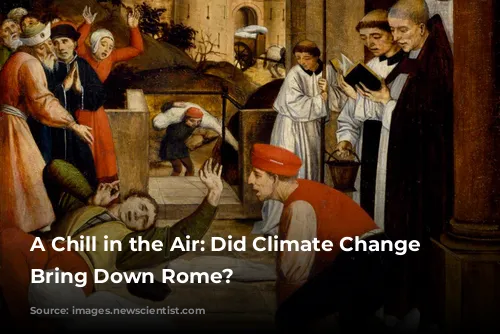Dive into the fascinating world of ancient Rome, where climate and disease intertwined to shape history! This article explores a captivating study that reveals a surprising connection between climate change and the devastating pandemics that plagued the Roman Empire.
A Shocking Link Between Climate and Pandemic
We know that pandemics ravaged the Roman Empire, leaving an indelible mark on history. But did you know that these outbreaks may have been linked to a dramatic shift in climate? A groundbreaking study suggests that three major pandemics that shook the Roman world coincided with unusually cold and dry periods. Could these climate changes have played a role in Rome’s decline?
Unlocking the Secrets of the Past
To understand the relationship between climate and disease, scientists delved into the depths of the Adriatic Sea. By analyzing ancient marine sediments, they reconstructed the climate of southern Italy over a period of 800 years, spanning from 200 BC to 600 AD. These sediments, like time capsules, preserve the remnants of past life, including tiny plankton.
A Flourishing Empire, Then a Chill
For centuries, Rome thrived during a period of warm and wet weather, known as the “Roman Climate Optimum”. This period saw the Empire flourish, reaching its greatest extent. But around 130 AD, a dramatic shift occurred. Temperatures plummeted by as much as 3°C (5.4°F), and the region experienced more frequent droughts. This change in climate coincided with the emergence of devastating pandemics.
Cold Years, Deadly Plagues
The study reveals a chilling correlation. The Antonine Plague (165-180 AD), a devastating outbreak that shook the empire, occurred during a particularly cold period. This pandemic is believed to have even claimed the life of Emperor Lucius Verus.
Another drop in temperatures coincided with The Plague of Cyprian (251-266 AD). This period saw the empire teetering on the brink of collapse, fractured by warring generals and rebellions.
Then, following the fall of the Western Roman Empire in 476 AD, one of the coldest periods in the past 2000 years ushered in a wave of pandemics, starting with the Plague of Justinian (540s). This pandemic decimated populations across the Eastern Roman Empire, contributing to the loss of vast territories, including Italy, the Balkans, and the Middle East.
Climate Change: A Hidden Driver of Disease?
The evidence points to a troubling connection: a chilling correlation between climate change and the rise of pandemics. Cooler, drier conditions may have disrupted agricultural harvests, weakened the immune systems of Roman citizens, and fueled the spread of disease through migration and conflict.
While the study focuses on the Roman heartland, similar evidence of these cold spells can be found in tree rings from the northern Alps. The study also reveals the impact of these climate changes on marine life. Warm-water plankton species declined during these cold periods, indicating a shift in the marine ecosystem.
Volcanic Eruptions and the Late Antique Little Ice Age
These climate shifts were not merely natural fluctuations. Before the Plague of Justinian, three massive volcanic eruptions dimmed the sun and triggered a period known as the Late Antique Little Ice Age. Historical accounts from this time describe crop failures and a world plunged into darkness.
“The sun gave forth its light without brightness, like the moon,” wrote the scholar Procopius in 536. “Men were free neither from war nor pestilence nor any other thing that brings death.”
A Complex Web of Factors
While this study sheds light on the impact of climate change on Roman Italy, it is crucial to remember that history is a complex tapestry woven from multiple threads. While the link between climate change and disease in Roman Italy is compelling, researchers emphasize that it is too early to definitively conclude that climate change caused or amplified the plagues.
Other factors, including social and economic factors, played a significant role in the decline of the Roman Empire.
A Warning From the Past
Despite the complexity, this study offers a stark reminder of the powerful impact of climate change on human societies. It highlights the potential for climate change to disrupt agriculture, weaken immune systems, and create the conditions for widespread disease.
The study serves as a cautionary tale from the past, emphasizing the importance of addressing climate change today. By understanding the past, we can better prepare for the challenges of the future.
